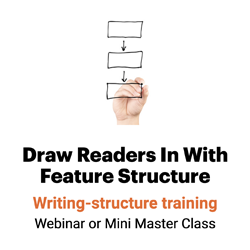Federal Home Loan Bank nails the feature
It was a good story: More than 1,000 New Englanders would soon have safe, decent, affordable places to live, thanks to the Federal Home Loan Bank of Boston’s Affordable Housing Program.

But PR convention demands that we reduce good stories to hierarchical blurtations of fact. And that’s what Mark Zelermyer, the bank’s vice president and director of corporate communications, did with the first draft of his news release covering the story.
But by the end of my NOT Your Father’s News Release Master Class, Mark had totally rewritten his release, taking the story from blah to brilliant. What can you learn from his before and after?
Get a refresher on the feature-style structure.
1. Headline and deck
Mark started out focusing on “us and our stuff”:
FHLB BOSTON AWARDS $30.3 MILLION FOR AFFORDABLE HOUSING THROUGHOUT NEW ENGLAND
48 Initiatives Will Result in More Than 1,000 Units in Six States
But his rewrite focuses on the impact, not on the event, of the program.
MORE THAN 1,000 NEW ENGLANDERS TO GAIN AFFORDABLE HOUSING
Federal Home Loan Bank of Boston Awards $30.3 Million to 48 Projects
2. Lead
In his first draft, Mark crams all of the W’s into a fact pack lead:
The second version shows instead of tells, focusing on specific details about the program’s outcomes. That pulls readers into the story, and it communicates better than a wall of abstraction. Plus, at 24 words, it creates a bridge into the story instead of an obstacle to reading:
3. Nut graph
Mark didn’t write a nut graph for his traditional news release, because inverted pyramids don’t have nut graphs. But in his revision, Mark puts the story into a nutshell in a short nut graph:
4. Background section
In the first draft, Mark gives some context in the quote, then shares perhaps more background information than anyone who doesn’t work at the bank cares to know about how the program works:
AHP funds are used to help pay construction, acquisition, or rehabilitation costs. Member financial institutions work with local developers to apply for AHP funding, which is awarded through a competitive scoring process.
In the second version, Mark streamlines the “how it works” section into a short paragraph, then follows up with the context in a more manageable quote:
“Investing in affordable housing does more than provide homes,” said Edward A. Hjerpe III, the Bank’s president and chief executive officer. “It creates jobs and boosts the economy across our region.”
5. Body
The juicy details are buried in the body of Mark’s first version:
- Habitat for Humanity energy-efficient ownership homes.
- Supportive housing for 18- to 22-year-olds after they leave foster care. All units will be targeted to individuals earning below 30 percent of the area median income.
- Housing with on-site health care and mental health services for survivors of brain injury and related cognitive disorders.
- Rehabilitation of a former shoe factory mill building into 42 rental units for low-and very low-income households.
The following communities will benefit from FHLB Boston AHP funds:
- Connecticut: Bloomfield, Bridgeport, Niantic, and Stamford.
- Maine: Bangor, Brunswick, Dover Foxcroft, Ellsworth, and Houlton.
- Massachusetts: Acton, Amherst, Boston, Chelsea, Danvers, Falmouth, Florence, Gilbertville, Haydenville, Lawrence, Lowell, Lynn, New Bedford, Orleans, Rockport, Salem, Turners Falls, and West Tisbury.
- New Hampshire: Concord, Dover, Franklin, Marlborough, Newport, and Wolfeboro.
- Rhode Island: Coventry, Cumberland, East Greenwich, Newport, Pawtucket, Providence, Richmond, and Warwick.
- Vermont: Burlington, Hancock, Manchester Center, Rutland, and Vergennes.
The body in the revision covers just the facts of importance to people — and, OK, Google — who may be seeking information about housing in their own communities:
- Connecticut: Bloomfield, Bridgeport, Niantic, and Stamford.
- Maine: Bangor, Brunswick, Dover Foxcroft, Ellsworth, and Houlton.
- Massachusetts: Acton, Amherst, Boston, Chelsea, Danvers, Falmouth, Florence, Gilbertville, Haydenville, Lawrence, Lowell, Lynn, New Bedford, Orleans, Rockport, Salem, Turners Falls, and West Tisbury.
- New Hampshire: Concord, Dover, Franklin, Marlborough, Newport, and Wolfeboro.
- Rhode Island: Coventry, Cumberland, East Greenwich, Newport, Pawtucket, Providence, Richmond, and Warwick.
- Vermont: Burlington, Hancock, Manchester Center, Rutland, and Vergennes.
6. Wrapup
Mark ends with a call to action in each version:
But wait! There’s more …
In addition to making his story more compelling, Mark also make it more than 30% more readable. To do so, he:
- Slashed the length of the lead paragraph by 70%
- Cut word count by 37%
- Streamlined sentences by 25%
- Reduced passive voice by 77 percentage points
It’s no surprise that Mark suggested we change the name of our PR-writing Master Class to “The News Release Makeover.”

Leave a Reply